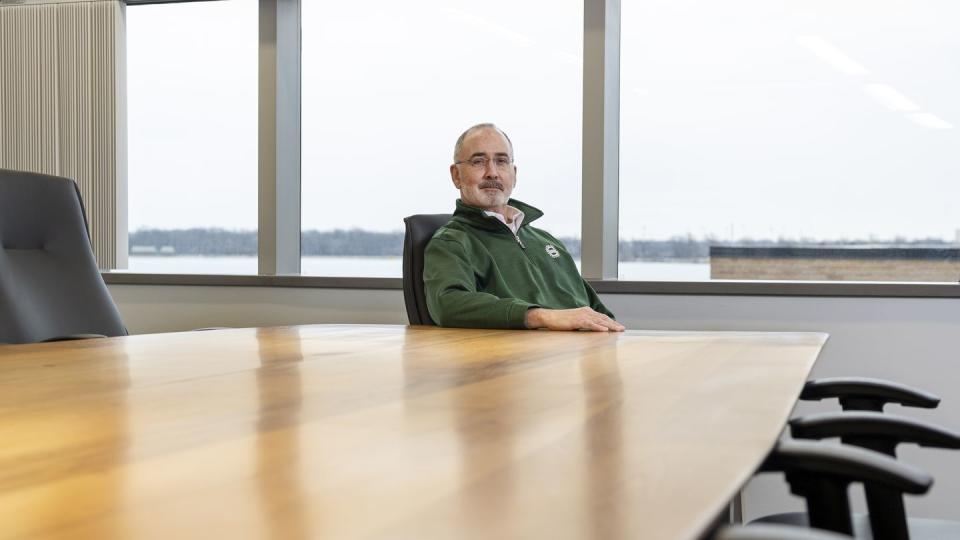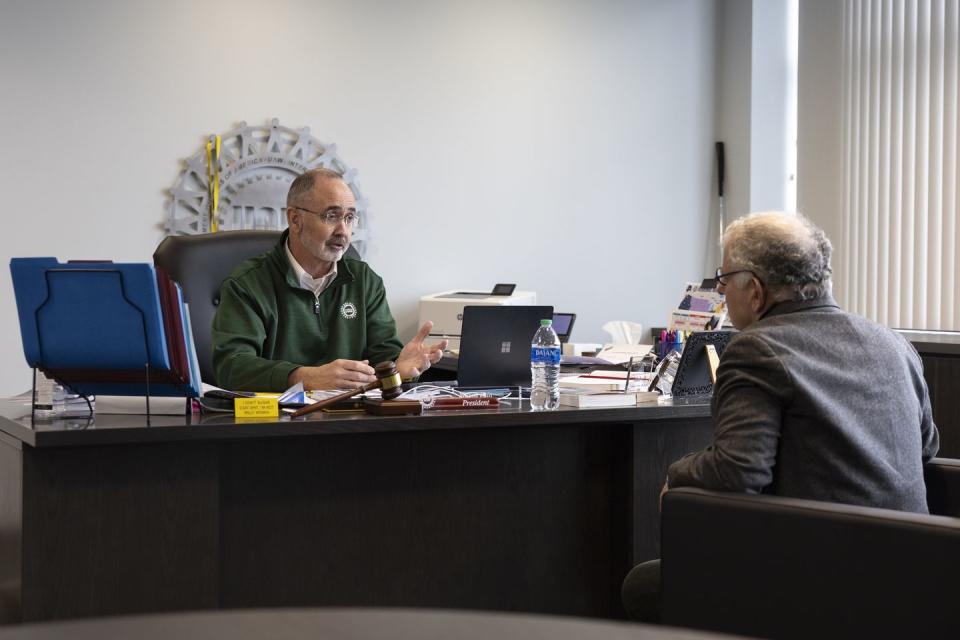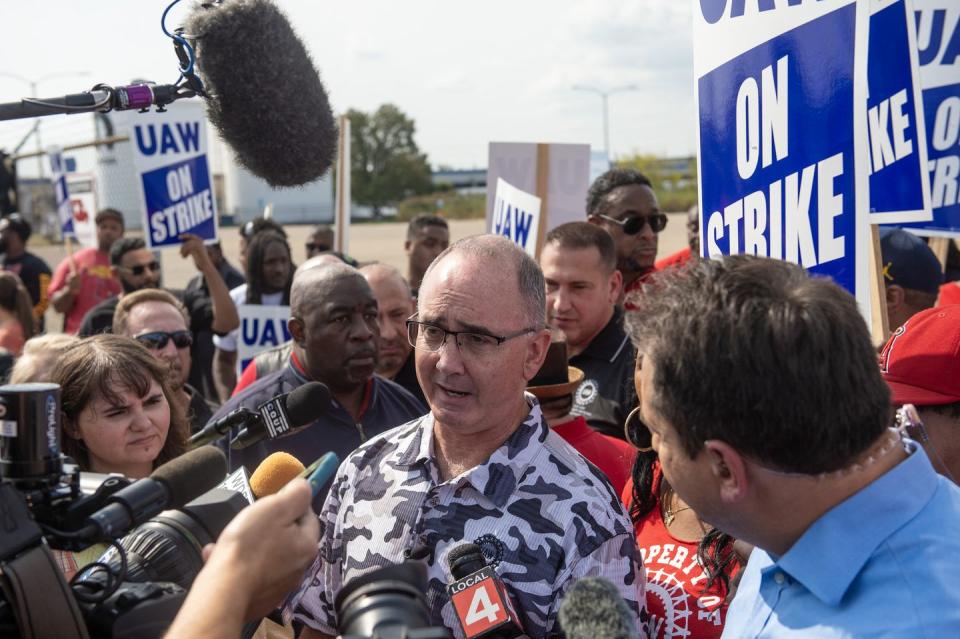UAW Leader Shawn Fain Is Bullish on the American Auto Worker

United Automobile, Aerospace and Agricultural Implement Workers of America president Shawn Fain is the UAW's most outspoken leader since Walter Reuther took the top job in 1946. An electrician by trade—and the proud owner today of a 2010 Dodge Charger ("It’s got a Hemi," he says) and a 1984 Chevrolet El Camino, handed down from his grandfather—Fain originally took a job at Chrysler's Kokomo, Indiana, factory in 1994. Becoming a union committee person, he ran against the grain of the union's national leadership, notably opposing givebacks agreed during the 2007–2009 recession.
He might have been just a bothersome but easily ignored union dissident were it not for the 2022 felony convictions of 14 UAW officials and three FCA executives for fraud and corruption, including embezzlement. After the corruption of its management was exposed, union membership voted to elect their leader directly for the first time, giving outsider Fain a fighting chance. He won an upset victory over the Caucus's preferred candidate and assumed the presidency in March 2023.
As the big American carmakers' UAW agreements drew close to their September 2023 expiration date, Fain articulated, in unusually blunt language, workers' outrage over wages that failed to keep pace with inflation and benefits dramatically inferior to those paid in previous decades, shortfalls compounded by the introduction of a "two tier" wage system that saw new hires paid less than existing employees. Givebacks remained through years of record industry profits and skyrocketing executive compensation. When the companies failed to come close to meeting the UAW's demands, a strike was declared, with the union choosing to strike all three Detroit automakers at once rather than pick a single "target" as in years past.
Stand Up Strike
Thanks to a new, young staff utilizing social media with a sophistication unseen in previous campaigns, the UAW was able to rally its membership as well as capture the sympathy of the media and the public. Further catching carmakers off guard, the union's "Stand Up Strike" strategy shut down production at individual factories, saving the union money in benefits owed versus company-wide actions. By late October, the carmakers cried uncle, signing record contracts with average wage increases of at least 25 percent over four and a half years, including a 160 percent hike for newer employees long classified as temporary. Cost-of-living adjustments to offset inflation—eliminated in previous contracts—were restored, and Stellantis agreed to reopen a factory in Belvidere, Illinois.
In the wake of the settlement, several companies, including Hyundai, Kia, Volkswagen, Toyota, Honda, and Tesla, gave their workers unsolicited raises, looking to circumvent unionization.
Recently, Jamie Kitman sat down with Fain at the UAW’s Detroit headquarters, Solidarity House. Their discussion has been edited for length and clarity.

Car and Driver: One notable thing about this negotiation was how quickly and successfully the union defined the issues. It seemed to catch carmakers flat-footed. It also seemed like management couldn't believe the tenor of the union's public statements and the public's generally supportive response. How did that happen?
Shawn Fain: Like a lot of our members, I was extremely frustrated with our leadership in the past. The corruption was one thing. But even prior to that. What they call "working together," I call "company unionism." All we witnessed out of that philosophy is losing plants, losing jobs. We watched, over 20 years, 65 factories [owned by] the Big Three disappear. "Working together," as I view it, would be when it's a win-win for everybody. It's not one-sided.
I've been in national bargaining in the past—I was a negotiator during the recession and the Chrysler bankruptcy. I saw then how the company went after everything and took advantage of a bad situation. Workers bore the brunt of all that sacrifice. Moving forward, we've sat here for over a decade, watching the Big Three make massive profits. And so it really felt like, right from the beginning, we had to set the tone and do things differently.
We ran the contract campaign to define the narrative and define the issues. In the last decade, the [Big Three] companies made a quarter-trillion dollars in profits. CEO pay went up 40 percent in the last four years. And our pay went backwards. So that was really setting the table.
Was that intended as an internal campaign or public as well?
When I ran for this position, I had to run a campaign. I didn't have the advantages that the former administration caucus people had because they were in power. They could fly all over the country on the union's dime and visit plants under the guise of union business. People like me who were running had to take vacation [time] and go stand out at plant gates and hope to catch workers coming and going. So I relied on social media to get who I was out there and to interact with members all over the country, because that was really the only way I could do it effectively. I started using Facebook Live throughout my campaign. We really were doing this as a way to communicate with our members. But it turned into a lot more because social media brought in anyone that wanted to come in. The general public was paying attention, the news media paid attention. And I think it was really effective, because when it got time to go on strike, 75 percent of Americans supported us.
That was unexpected. And so was the lack of media hostility. I guess it made me think that the management of the car companies really never had to work very hard before to get their message out.
Companies were used to having their way, saying what they wanted and getting it. I don't think they really knew how to handle leadership that wasn't operating in that mode. In the past, our leaders would stand up and beat the podium and say, "We're gonna fight, we're gonna fight, fight, fight!" And then when they got into negotiations, they'd roll over.
[In the past,] the companies were... putting their opinions out and leading public opinion about these greedy union workers and how they're going to destroy everything. And when that's all the public's hearing, it's going to create a narrative. I think it's imperative that we communicate with the media and talk about our issues. And I would use our contract campaign and our strike as a case study of how effective it can be.

The companies are already blaming your new contract for price hikes.
Over the last four years the price of vehicles went up 35 percent on average. But our wages didn't go up. Our benefits didn't get better. Nothing changed for us. The price hikes are because of two things: corporate greed and consumer price gouging. Coming out of the pandemic, they found a way to take advantage of consumers. They jacked prices way up and sold fewer vehicles but made more profits. So that's the first part of this equation—they've got to quit lying to the public and putting fear out there that if workers are paid what they're worth, it's going to kill the business. It's not.
GM did manage to afford a $10 billion share buyback and dividend hike almost exactly at the same time as they settled the contract negotiation.
They’re crying and crying about our contract. Two weeks later, they gave more in buybacks and dividends than they spent on this entire contract. Labor costs historically are only 5 to 7 percent of the total cost of an automobile. [Carmakers] could give us everything they gave us in that contract and not raise the price of cars a penny and still make massive profits. Why are they not complaining about what those dividends and buybacks cost them? They affect the bottom line more.
I really enjoyed watching [GM chair and chief executive officer] Mary Barra in an interview when the interviewer actually asked her, "You got a 40 percent pay increase over the past four years, you made $29 million last year, and your workers are asking for an increase, and why do you think it's okay for you to make what you make?" You could see her just be, like, "Um, I'm paid by the board for the value of the work I do." But it was great to see someone be asked that question, because that answer is bullshit.

 Yahoo Autos
Yahoo Autos 